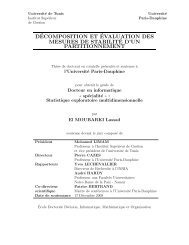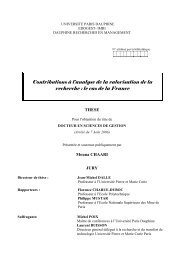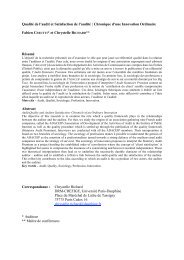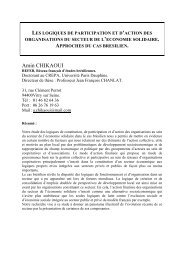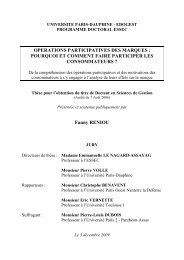12-02-Cahier-R- ... e-Chevallier-Gastineau.pdf - Base ...
12-02-Cahier-R- ... e-Chevallier-Gastineau.pdf - Base ...
12-02-Cahier-R- ... e-Chevallier-Gastineau.pdf - Base ...
You also want an ePaper? Increase the reach of your titles
YUMPU automatically turns print PDFs into web optimized ePapers that Google loves.
mental impact of the growth of air transport. The first one consists in improving the energy<br />
efficiency of aircrafts (and thus to lower their carbon intensity) by promoting technological<br />
innovation. The second one consists in binding measures dealing with the demand for air<br />
transport 5 . These two types of measures are not antinomic and may be pursued simultane-<br />
ously. For instance, the European Commission actively promotes innovation efforts by air<br />
companies through Research & Development (R&D) programs 6 , while also taking binding<br />
actions with the inclusion of aviation in the EU ETS. However, these public policies do not<br />
follow the same logic. Indeed, the latter kind of measure deals directly with the causes of<br />
greenhouse gases emissions linked to the growth of the air transport sector, while the former<br />
kind of measure only attempts at diminishing its negative consequences.<br />
There is a sharp debate today on the best course of action to reduce significantly, and<br />
within a reasonable time horizon, greenhouse gases emissions in the air transport sector. Will<br />
technological changes 7 be sufficient to outweigh growth in fuel use? In other words, shall we<br />
solely aim at reducing the carbon intensity of the air transport sector through innovation? Or<br />
shall we admit that technological innovation alone does not allow to achieve the objectives<br />
of stablization and reduction of greenhouse gases that were set? In both cases, shall we limit<br />
the development of the air transport sector?<br />
The actors in the aeronautical industry tend to reject majoritarily the second kind of<br />
measure. For instance, concerning the inclusion of the air transport sector in the EU ETS,<br />
governments and international airlines outside Europe protest against this measure. Oppos-<br />
ing states (including Brazil, the U.S., China, and Japan) claim that the unilateral application<br />
of the EU ETS to international aviation violates the ‘cardinal principle of state sovereignty’,<br />
and assert that non-EU aircraft operators should be exempt from this trading scheme. Aero-<br />
5 To be more precise, there are actually four general types of mitigation-related measures: climate policy,<br />
behavioural change, management and new technologies. All of these, with the exception of behavioural change,<br />
are supposed to contribute to efficiency gains in the aviation sector. Behavioural change, on the other hand, is<br />
supposed to make a contribution through low carbon choices (shorter flight distances, more environmentally<br />
pro-active airlines, direct flights, etc.).<br />
6 Two main projects are devoted currently to alternative fuels (other than jet fuel) for aviation. The program<br />
Alfa-Bird, which was created in 2008 for a period of four years and coordinated by Airbus, aims at better<br />
identifying the needs in terms of research and investments. The Swafea program, lead since January 2009 by<br />
the French Aerospace Lab, aims at elaborating a roadmap for deploying alternative fuels in the mid-term.<br />
Many industrial actors (Airbus, Avio, Dassault, EADS, Rolls-Royce, Safran, Sasoil, Shell, Snecma, etc.) are<br />
participating to these programs, along with public research centers.<br />
7 Notably including the development of biofuels.<br />
4






